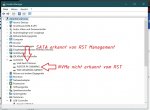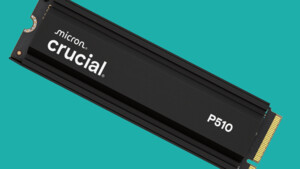Du verwendest einen veralteten Browser. Es ist möglich, dass diese oder andere Websites nicht korrekt angezeigt werden.
Du solltest ein Upgrade durchführen oder einen alternativen Browser verwenden.
Du solltest ein Upgrade durchführen oder einen alternativen Browser verwenden.
Intel RST Treiber für M.2 SSD?
- Ersteller thommy86
- Erstellt am
J
jodd
Gast
M.2 SSD sagt gar nichts aus. Die Anbindung ist ausschlaggebend: SATA oder NVMe?
- Registriert
- März 2009
- Beiträge
- 2.467
NvME müsste es sein. Habe den Crucial P1 SSD 1TB M.2https://www.notebooksbilliger.de/cr...afn74NxKR7bguWhTMSEoPAd2mkCoaAqQtEALw_wcB:G:s
J
jodd
Gast
| Schnittstelle | PCIe Gen 3.0 4x NVMe 1.3 |
Damit ist der RST unnötig.
Noch so ein überbewerteter Treiber, "Intel RST Treiber ".
Für RAID wohl zu gebrauchen aber ansonsten völlig unnötig für eine SSD.
Die Windows Standard Treiber sind sehr stabil und nicht langsamer, auch wenn
gewisse Benchmarks was anderes suggerieren .
Für RAID wohl zu gebrauchen aber ansonsten völlig unnötig für eine SSD.
Die Windows Standard Treiber sind sehr stabil und nicht langsamer, auch wenn
gewisse Benchmarks was anderes suggerieren .
shadowrid0r
Commander
- Registriert
- Juni 2008
- Beiträge
- 2.053
Da Crucial meines Wissens nach keinen eigenen NVMe Treiber anbietet, kann man nur den stornvme von Microsoft nehmen, der bei Windows schon dabei ist.thommy86 schrieb:Gibt dafür ein anderen Treiber?
Da muss man ihn sogar nehmen, wenn man das RAID am Chipsatz macht, auch bei NVMe SSDs.Nickel schrieb:Für RAID wohl zu gebrauchen
Und welchen Treiber nimmst Du dann für ein NVMe RAID an den Intel Chipsätzen? Das NVMe RAID an den Chipsätzen geht nur mit dem Intel RST Treiber, denn dafür musste Intel nämlich einen Trick mit den Registern des SATA Controllers anwenden.
Oder lies Dir Anleitungen durch wie man ein solche RAID aufsetzt, welche Modus der SATA Host Controller haben muss und welchen Treiber man dann nimmt.
Ähnliche Themen
- Antworten
- 39
- Aufrufe
- 14.466
- Antworten
- 3
- Aufrufe
- 789
- Antworten
- 11
- Aufrufe
- 1.310





